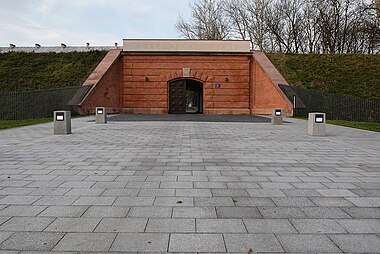Katyn Museum
The Katyn Museum (in Polish: Muzeum Katyńskie ) in Warsaw houses an exhibition on the prehistory, implementation and consequences of the Katyn massacre , in which around 4,000 Polish officers were murdered by the Soviet secret service NKVD in 1940. Since September 2015 it has been located on the grounds of the Warsaw Citadel .
history
When it was founded in 1993, the museum was initially housed in a branch of the Museum of the Polish Army in the former "Czerniakowski" Fort ( Fort IX of the Warsaw Fortress ) in the south of Warsaw. In 2009 the site was closed by the construction police.
The following year the decision was made to move it to the citadel north of the old town . It was opened jointly by President Andrzej Duda and Prime Minister Ewa Kopacz on September 17, 2015 . The opening date was the 76th anniversary of the Soviet invasion of eastern Poland , during which the Polish officers who were later murdered in Katyn and other places were taken prisoner.
The museum is subordinate to the Polish Ministry of Defense .
exhibition
The exhibition concerns not only those murdered in Katyn, but also the Polish victims of Kharkiv and Kalinin , who were also murdered by the NKVD in 1940. In the basement area of the museum, over 6000 mainly personal items of the murdered people are exhibited, which were found when the mass graves were opened between 1991 and 1994. In the actual exhibition, the guest learns more about the course and history of the massacre. In addition, documents, photos and films on the executions, the victims and the excavations are shown and archived. In addition to the publicly accessible exhibition, historians can also look into the archive. In addition, a complete directory of the victims was created.
Surroundings and roll call area
The museum is located on the grounds of the 19th century Warsaw Citadel. The exhibition was placed in a caponier in the southeastern part of the citadel. Before entering the actual museum, one crosses a roll call area where young hornbeams have been planted. These symbolize the mass graves in the depths of the Russian forests. After the mass murders, the Russian soldiers planted young trees at the crime scene.
At the intersection of Krajewski Street and Wybrzeże Gdyńskie Street (also known as Wisłostrada) the "Katyn Bell" was placed in front of the citadel wall. It weighs 2 tons and hangs on a special frame. Since the bell was cast with a hole, its sound is not ideal. Next to the hole is a military Polish eagle from the time of the Second Polish Republic in the form of a relief. On the other side of the bell, the text of the "Rota" was put on. This is the first bell in the world that was made with such a "holey" symbol. The outer wall was covered with a lead patina and is illuminated from the inside. The sound of the bell is c sharp 1, which is generated by electromagnetic hammers from Rduch Bells & Clocks.
Jerzy Kalina designed the bell. It was cast by the Jan Felczyński bell foundry from Przemyśl.
Head of the museum
- Zdzisław Sawicki, 1993-2000
- Sławomir Błażewicz, 2000–2002
- Sławomir Frątczak, 2002-
- Ewa Kowalska, 2015–
literature
- Cordula Kalmbach: Remembering the massacre: Katyn as lieu de mémoire of the Polish culture of remembrance . Peter Lang Edition, Frankfurt am Main 2015, ISBN 978-3-631-65871-0 , pp. 269-271.
- Sławomir Frątczak: Muzeum Katyńskie - oddział Muzeum Wojska Polskiego 1993–2003 . In: Niezależny Komitet Historyczny Badania Zbrodni Katyńskiej (ed.): Zeszyty Katyńskie . Zbrodnia Katyńska a problem przebaczenia, No. 17 . Warsaw 2003, ISBN 83-905877-9-4 ( formally incorrect ) , p. 105–117 ( online ( memento of October 3, 2010 in the Internet Archive )).
See also
Web links
- Muzeum Katyńskie Museum website (Polish, English)
- Portrait of the museum on YouTube (10 minutes)
Individual evidence
- ↑ Walka o własność pamiątek katyńskich. Section: Czekając na prawdziwe muzeum. www.rp.pl - Plus Minus, August 27, 2011, accessed on November 28, 2016 (Polish).
- ↑ Muzeum Katyńskie. Na zwiedzanie trzeba poczekać do listopada. In: gazeta.pl , October 6, 2015.
- ↑ Muzeum Katyńskie. Współczesny język i czysta forma. In: gazeta.pl , September 13, 2015.
- ↑ according to the information The Polish Military Museum ( page no longer available , search in web archives ) Info: The link was automatically marked as defective. Please check the link according to the instructions and then remove this notice. at Culture.pl
- ↑ Photo gallery from the installation in 2015 - source: www.janfelczynski.com
- ↑ Assembly of the bell on Youtube
- ↑ af: "Przestrzelony" Dzwon Katyński powstał w słynnej pracowni Jana Felczyńskiego. In: www.portalprzemyski.pl. August 10, 2015, accessed November 28, 2016 (Polish).
- ↑ Agnieszka Pochrzest-Motyczyńska: Dzwon Katyński ze po śladem pocisku Stanal obok Cytadeli. www.warszawa.wyborcza.pl, August 4, 2016, accessed November 28, 2016 (Polish).
Coordinates: 52 ° 10 ′ 57.1 ″ N , 21 ° 4 ′ 4.6 ″ E

